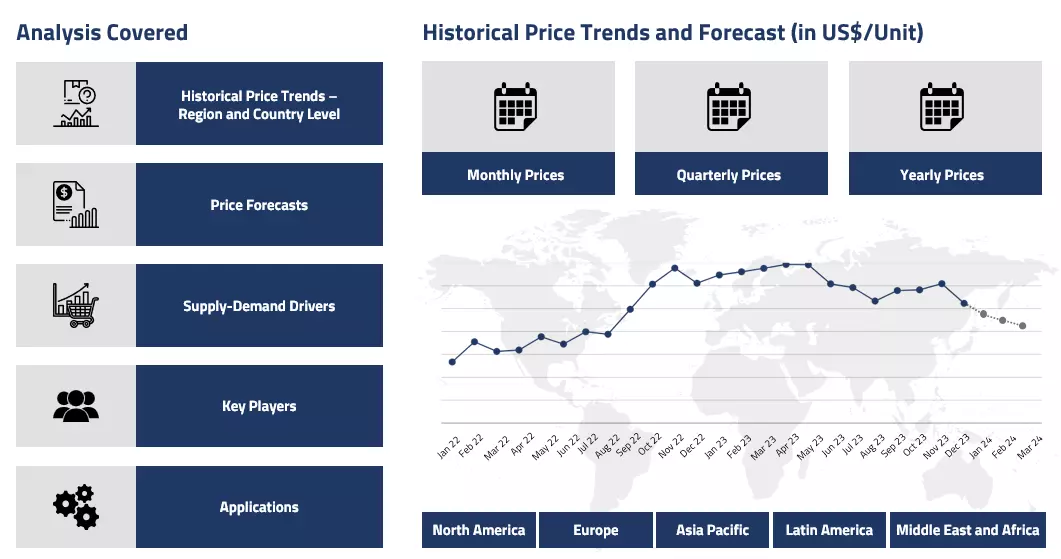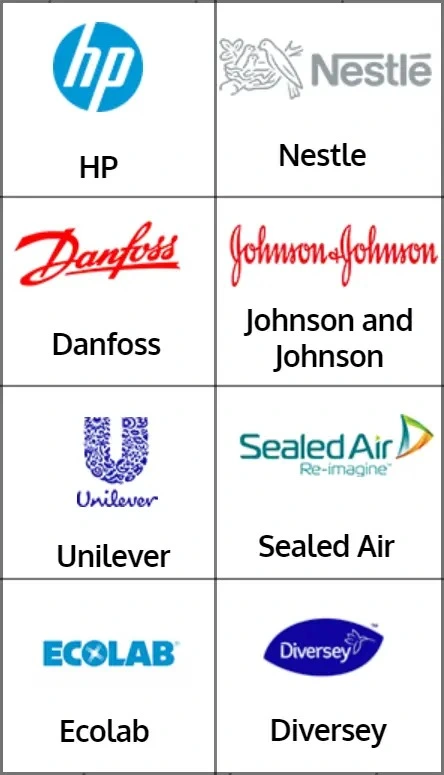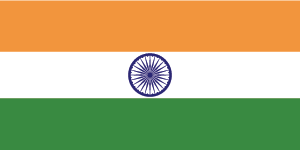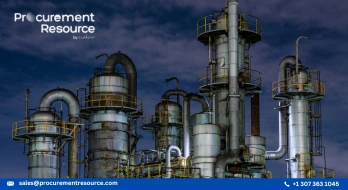Product
Petroleum Jelly Price Trend and Forecast
Petroleum Jelly Price Trend and Forecast
Petroleum Jelly Regional Price Overview
Get the latest insights on price movement and trend analysis of Petroleum Jelly in different regions across the world (Asia, Europe, North America, Latin America, and the Middle East & Africa).
Petroleum Jelly Price Trend for Q1 of 2025
Asia
Asian petroleum jelly prices mirrored the trend of crude oil, its primary feedstock, in the first quarter of 2025. Prices initially rose as demand from the pharmaceutical and cosmetic sectors increased, particularly for creams, lotions, and ointments. Since petroleum jelly is a byproduct of crude oil, higher crude prices contributed to the price surge.
Petroleum Jelly Price Chart

Please Login or Subscribe to Access the Petroleum Jelly Price Chart Data
Additionally, supply disruptions during the Chinese New Year further supported this upward trend. However, after peaking, prices began to decline, eventually stabilizing by the end of the quarter as supply chains adjusted. Industrial demand, particularly for lubricants and anti-corrosion coatings, provided some support, but the overall price movement reflected crude oil volatility starting with an early surge, followed by a mid-period decline, and concluding with stabilization.
Europe
In the European region, petroleum jelly prices followed a similar trajectory, rising at the beginning of the quarter as the pharmaceutical and personal care industries built inventories. Strong demand for wound care, medical formulations, and skincare applications pushed prices upward. However, as crude oil prices declined, petroleum jelly prices followed suit, with refiners scaling back production and supply increasing. By March, prices stabilized, supported by steady demand from industrial and food-grade applications, which prevented further declines. While some volatility was present, the market remained relatively stable due to sustained consumption across various sectors.
North America
In North America, petroleum jelly prices started strong, driven by seasonal demand during the winter months. Increased demand for medical and skincare products sustained the upward trend as industries resumed operations after the New Year holidays. However, when crude oil prices declined in February, petroleum jelly prices followed suit, reflecting lower production costs.
By the end of the quarter, the market stabilized, with steady demand from sectors such as mechanical lubrication, rust protection, and food-grade applications preventing further declines. The petroleum jelly price chart for the quarter showed an initial spike, a mid-quarter decline, and a stabilized market toward the close, mirroring trends in the upstream crude oil market.
Analyst Insight
According to Procurement Resource, the petroleum jelly price graph is expected to show range-bound movements in the near future amid stable supplies; however, summer months could affect the demand for the commodity.
Petroleum Jelly Price Trend for the Year 2024
Asia
Price movements in the petroleum jelly market in Asia closely followed crude oil price trends throughout 2024. At the beginning of the year, prices remained relatively stable due to a steady supply and consistent demand from the cosmetics, pharmaceuticals, and industrial sectors. However, as the second quarter approached, crude oil prices rose sharply due to production cuts under OPEC+ agreements and geopolitical instability, which led to higher refining costs. Consequently, petroleum jelly prices increased, with manufacturers passing the added costs on to buyers.
Prices continued to rise in the third quarter, driven by strong demand from the skincare and pharmaceutical industries, along with rising freight costs. However, the fourth quarter saw crude oil prices decline, signaling a market shift. As refining costs decreased, petroleum jelly prices also dropped, particularly as industrial buyers reduced their purchases. While demand from the personal care and pharmaceutical sectors remained steady throughout the year, inventories ended at lower levels.
Europe
At the start of the year, petroleum jelly prices in Europe were high due to rising crude oil prices and ongoing supply chain issues. OPEC+ production policies kept refining costs elevated, making it difficult for refiners to manage feedstock expenses in the first half of the year. This resulted in an upward price trend, with the second quarter witnessing peak prices due to persistently high crude oil costs and supply chain disruptions. However, in the fourth quarter, the market shifted as crude oil prices declined, easing cost pressures on refiners. With industrial demand weakening, price reductions were observed amid the seasonal slowdown leading up to the Christmas holidays.
North America
The North American petroleum jelly market started the year on a strong note, with rising crude oil costs contributing to price increases. Demand from the beauty, medical, and lubricant industries remained robust, adding to the price pressure. Refining costs also rose, further sustaining the upward trend. Despite global supply challenges and rising crude oil prices, petroleum jelly prices continued to climb throughout the second quarter.
Prices remained elevated in the third quarter due to persistent consumer demand and supply constraints. However, as crude oil prices declined in the fourth quarter, production costs dropped, leading to a decrease in petroleum jelly prices. Industrial buyers also reduced bulk purchases toward the end of the year, further contributing to the downward trend.
Analyst Insight
According to Procurement Resource, the petroleum jelly price curve is expected to remain tied to the fluctuations in the crude oil market in the upcoming quarter.
Petroleum Jelly Price Trend for the Second Half of 2023
Asia
Petroleum jelly is a direct residue of oil rigs after the crude oil distillation process is done, so the fluctuations in the crude oil markets are also reflected in the petroleum jelly prices. During the said period of the H2 of 2023, the prices were observed to be fluctuating in the Asian markets.
The petroleum jelly prices surged in the third quarter as OPEC+ put restrictions on oil exports to stabilize the global oil markets, and the edge the Indian and Chinese oil industries received by importing the sanctioned Russian oil was also not helping anymore. So, the petroleum jelly market was very firm throughout the third quarter in both India and China. However, the same cannot be said about the last quarter, as the prices here started to show reverse fluctuations. This was mainly due to excessive inventories and subdued demands. Overall, mixed market sentiments were witnessed.
Europe
The European petroleum jelly market behaved in a very similar manner to the Asian market. The market prices here too varied differently in both quarters. The third quarter was more positively inclined than the fourth quarter. And this market behavior was primarily linked to the crude oil supplies in the region.
The third quarter saw a global surge in oil prices, which eventually also pulled the petroleum jelly prices up. However, the fourth quarter was completely opposite as the prices during this time majorly fluctuated at the lower end of the curve. A dip in demand led to this downfall in the petroleum jelly price curve.
North America
The North American petroleum jelly market closely resembled its Asian and European counterparts during the second half of the year 2023. The prices here, too, fluctuated as per the fluctuations in the crude oil market. The first three months were firmer, and the suppliers withheld the stocks to manipulate the market in the winter months. However, the Red Sea issues changed the dynamics by curtailing offshore trade, and this made the market dependent on domestic consumption. As a result of this, the petroleum jelly prices came crashing down in the subsequent quarter. Overall, varying market sentiments were observed.
Analyst Insight
According to Procurement Resource, Petroleum Jelly price trends are likely to suffer more with dull demands going forward in the coming months as well.
Petroleum Jelly Price Trend for the First Half of 2023
Asia
The first quarter witnessed a consistent growth in the prices of petroleum jelly as the onset of the Chinese festival season helped in boosting the demand. In addition to this, the growth of packaging materials also aided the upward journey of petroleum jelly prices. The second quarter, however, failed to maintain this momentum as the prices began to decline.
The market witnessed a consistent decline during this quarter as the cost of raw materials failed to provide the market with the required support. Additionally, the falling construction and manufacturing activities proved to be unfavorable for the petroleum jelly price trend.
Europe
The surge in demand for petroleum jelly supported the rise in its price trend in the first quarter of 2023. In many countries, the laborers went on a strike that hampered the production rates and dried up the inventory levels, benefitting the rise in the prices of petroleum jelly. However, in the second quarter, the market winds changed, and demand for petroleum jelly dropped significantly. The major cause of this slump was the poor performance of the automobile and construction industries. Amid the weak economic conditions, the purchasing potential of buyers also took a hit, negatively affecting the prices of petroleum jelly.
North America
The North American rubber, packaging, and other related sectors had a fruitful first quarter, which helped in the growth of the petroleum jelly price trend. The supply was only able to cater to the demand of the domestic vendors; thus, the rise in the number of inquiries from overseas players supported the rise in the prices of petroleum jelly. Unlike the Asia-Pacific and European countries, the prices maintained this trajectory in the second quarter, too. A significant contributor to the incline in prices during this phase was the rise in the market share of battery-based electric cars.
Analyst Insight
According to Procurement Resource, the price trend of Petroleum Jelly is expected to oscillate in the upcoming months as the demand from the downstream industries and overall market dynamics seem uneven.
Procurement Resource provides latest prices of Petroleum Jelly. Each price database is tied to a user-friendly graphing tool dating back to 2014, which provides a range of functionalities: configuration of price series over user defined time period; comparison of product movements across countries; customisation of price currencies and unit; extraction of price data as excel files to be used offline.
About Petroleum Jelly
In appearance, Petroleum Jelly, is a semi-solid substance, which is a mixture of hydrocarbons (with carbon numbers mainly higher than 25). It is basically a mixture of mineral waxes and oils. The melting point of Petroleum Jelly lies somewhere between 40 and 70 °C (105 and 160 °F). Moreover, it does not oxidise upon exposure to air. It is widely used as a topical ointment or skin protectant owing its healing properties.
Petroleum Jelly Product Details
| Report Features | Details |
| Product Name | Petroleum Jelly |
| Industrial Uses | Personal care,ointment bases for veterinarian usage, Dermatological and opthalmic, creams and hand cleansers. |
| Synonyms | 8009-03-8, Petrolatum, White petrolatum, Soft paraffin |
| Supplier Database | Sasol Limited, Unilever PLC, Unisynth Oil Refinery India Ltd. (Unisynth Group), Raj Petro Specialities Pvt. Ltd, Sonneborn LLC, Eastern Petroleum Pvt. Ltd, Unicorn Petroleum Industries Pvt. Ltd, Kerax Limited |
| Region/Countries Covered | Asia Pacific: China, India, Indonesia, Pakistan, Bangladesh, Japan, Philippines, Vietnam, Iran, Thailand, South Korea, Iraq, Saudi Arabia, Malaysia, Nepal, Taiwan, Sri Lanka, UAE, Israel, Hongkong, Singapore, Oman, Kuwait, Qatar, Australia, and New Zealand Europe: Germany, France, United Kingdom, Italy, Spain, Russia, Turkey, Netherlands, Poland, Sweden, Belgium, Austria, Ireland Switzerland, Norway, Denmark, Romania, Finland, Czech Republic, Portugal and Greece North America: United States and Canada Latin America: Brazil, Mexico, Argentina, Columbia, Chile, Ecuador, and Peru Africa: South Africa, Nigeria, Egypt, Algeria, Morocco |
| Currency | US$ (Data can also be provided in local currency) |
| Supplier Database Availability | Yes |
| Customization Scope | The report can be customized as per the requirements of the customer |
| Post-Sale Analyst Support | 360-degree analyst support after report delivery |
Note: Our supplier search experts can assist your procurement teams in compiling and validating a list of suppliers indicating they have products, services, and capabilities that meet your company's needs.
Petroleum Jelly Production Process
- Production of Petroleum Jelly via Distillation
In order to produce Petroleum Jelly, the waxy petroleum material formed on oil rigs is used as a starting material. This crude material, which is made up of hydrocarbon mixture, undergoes vacuum distillation. This leaves behind a still residue, which is finally filtered using bone char to produce Petroleum Jelly.
Methodology
The displayed pricing data is derived through weighted average purchase price, including contract and spot transactions at the specified locations unless otherwise stated. The information provided comes from the compilation and processing of commercial data officially reported for each nation (i.e. government agencies, external trade bodies, and industry publications).
Assistance from Experts
Procurement Resource is a one-stop solution for businesses aiming at the best industry insights and market evaluation in the arena of procurement. Our team of market leaders covers all the facets of procurement strategies with its holistic industry reports, extensive production cost and pre-feasibility insights, and price trends dynamics impacting the cost trajectories of the plethora of products encompassing various industries. With the best analysis of the market trends and comprehensive consulting in light of the best strategic footstep, Procurement Resource got all that it takes.
Client's Satisfaction
Procurement Resource has made a mark for itself in terms of its rigorous assistance to its clientele. Our experienced panel of experts leave no stone unturned in ensuring the expertise at every step of our clients' strategic procurement journey. Our prompt assistance, prudential analysis, and pragmatic tactics considering the best procurement move for industries are all that sets us apart. We at Procurement Resource value our clients, which our clients vouch for.
Assured Quality
Expertise, judiciousness, and expedience are the crucial aspects of our modus operandi at Procurement Resource. Quality is non-negotiable, and we don't compromise on that. Our best-in-class solutions, elaborative consulting substantiated by exhaustive evaluation, and fool-proof reports have led us to come this far, making us the ‘numero uno' in the domain of procurement. Be it exclusive qualitative research or assiduous quantitative research methodologies, our high quality of work is what our clients swear by.
Related News
Table Of Contents
Our Clients

Get in Touch With Us

UNITED STATES
Phone:+1 307 363 1045

INDIA
Phone: +91 8850629517

UNITED KINGDOM
Phone: +44 7537 171117
Email: sales@procurementresource.com


